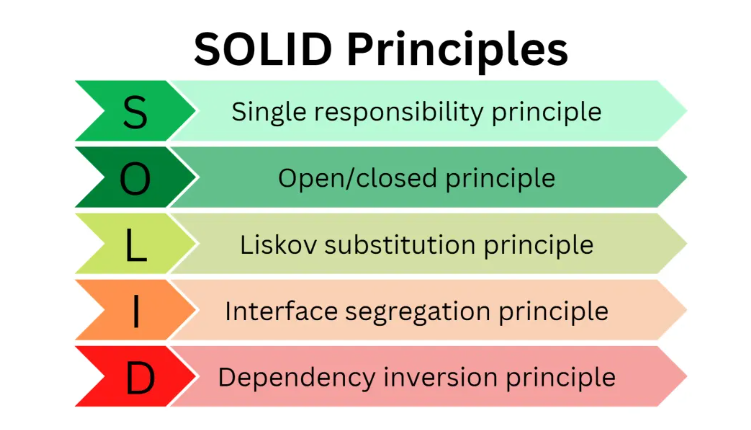-
0 Comments
Solid Principal in Object Oriented Programming
In software development, the SOLID principles are a set of guidelines that help in designing and organizing code to make it more maintainable, flexible, and scalable. The SOLID principles are as follows:
Single Responsibility Principle (SRP)
Read MoreThe Single Responsibility Principle (SRP) is a design principle that suggests that a class should have only one reason to change. In other words, a class should have a single responsibility or purpose. By adhering to this principle, we ensure that each class is focused on a specific task, making it easier to understand, maintain, and modify.
When a class has multiple responsibilities, it becomes tightly coupled and more prone to changes. If one responsibility needs to be modified, it may inadvertently affect other unrelated responsibilities within the class. This can lead to code that is difficult to understand and maintain.
By following the SRP, we can create more modular and cohesive code. Each class should have a clear and well-defined responsibility, and if there is a need for additional functionality, it is better to create a new class rather than adding it to an existing one.
Applying the SRP helps in achieving code that is easier to test, reuse, and extend. It promotes better separation of concerns and improves the overall maintainability and flexibility of the software system.
2. Open-Closed Principle (OCP)
The Open-Closed Principle (OCP) is a design principle that suggests that software entities (classes, modules, functions, etc.) should be open for extension but closed for modification. In other words, once a module or class is implemented and working correctly, it should be closed for any modifications. However, it should still be open for extension or adding new functionality.
The OCP encourages designing systems in a way that allows new features or behaviors to be added without modifying the existing code. This is typically achieved by using abstraction and polymorphism. By defining interfaces or abstract classes, we can create a contract that can be implemented by different concrete classes. This allows us to add new implementations without modifying the existing code that relies on the abstraction.
By adhering to the OCP, we can achieve code that is more maintainable, reusable, and scalable. Instead of modifying existing code and potentially introducing bugs or breaking existing functionality, we can extend the system by adding new classes or modules that adhere to the existing abstractions.
The OCP promotes the idea of designing software systems that are flexible and can easily accommodate changes and new requirements. It helps in reducing the impact of changes, improving code stability, and facilitating easier collaboration among developers working on different parts of the system.
3. Liskov Substitution Principle (LSP)
The Liskov Substitution Principle (LSP) is a design principle that states that objects of a superclass should be replaceable with objects of its subclasses without affecting the correctness of the program. In other words, if a program is using a base class, it should be able to work correctly with any derived class without needing to know the specific implementation details of the derived class.
The LSP ensures that the behavior and contracts defined by the base class are preserved by its subclasses. This principle helps in creating a more flexible and extensible codebase, as it allows new subclasses to be added without breaking existing code that relies on the base class.
To adhere to the LSP, subclasses must follow certain rules. They should not weaken the preconditions (input requirements) of the base class methods, meaning they should not demand more specific input than the base class. Subclasses should also not strengthen the postconditions (output guarantees) of the base class methods, meaning they should not provide less specific or different output than the base class.
By following the LSP, we can write code that is more maintainable, reusable, and robust. It promotes the concept of polymorphism, where objects of different classes can be treated interchangeably, enhancing the flexibility and scalability of the software system.
4. Interface Segregation Principle (ISP)
The Interface Segregation Principle (ISP) is a design principle that suggests that clients should not be forced to depend on interfaces they do not use. It emphasizes the idea of creating smaller, more specific interfaces instead of having a single large interface.
The ISP aims to prevent the problem of “fat” or bloated interfaces that contain more methods than what a client actually needs. When a client is forced to depend on an interface with unnecessary methods, it can lead to unnecessary coupling and potential issues when implementing or maintaining the code.
By adhering to the ISP, we can design interfaces that are tailored to the specific needs of clients. This allows clients to depend only on the methods they require, reducing unnecessary dependencies and potential conflicts.
The principle encourages the segregation of interfaces into smaller, cohesive units, each serving a specific purpose. This promotes better modularity, flexibility, and maintainability of the codebase. It also enables easier implementation of new functionality without impacting existing clients.
Overall, the ISP helps in creating more robust and loosely coupled systems by ensuring that interfaces are focused, concise, and relevant to the clients that use them.
5. Dependency Inversion Principle (DIP)
The Dependency Inversion Principle (DIP) is a design principle that suggests high-level modules should not depend on low-level modules. Instead, both should depend on abstractions. This principle promotes loose coupling and decoupling of modules in a software system.
In traditional software design, high-level modules often depend directly on low-level modules, creating a tight coupling between them. This can make the system rigid and difficult to change or maintain. The DIP addresses this issue by introducing abstractions, such as interfaces or abstract classes, that act as contracts between modules.
By depending on abstractions, high-level modules become independent of the specific implementations of low-level modules. This allows for flexibility and interchangeability of different implementations without affecting the high-level modules. It also enables easier testing, as dependencies can be easily mocked or replaced with alternative implementations.
The DIP encourages the use of dependency injection, where dependencies are provided to a class from external sources rather than being created within the class itself. This further promotes decoupling and flexibility, as dependencies can be easily swapped or modified without modifying the class itself.
Overall, the Dependency Inversion Principle helps in creating more modular, flexible, and maintainable software systems by promoting loose coupling and abstraction-based dependencies.





